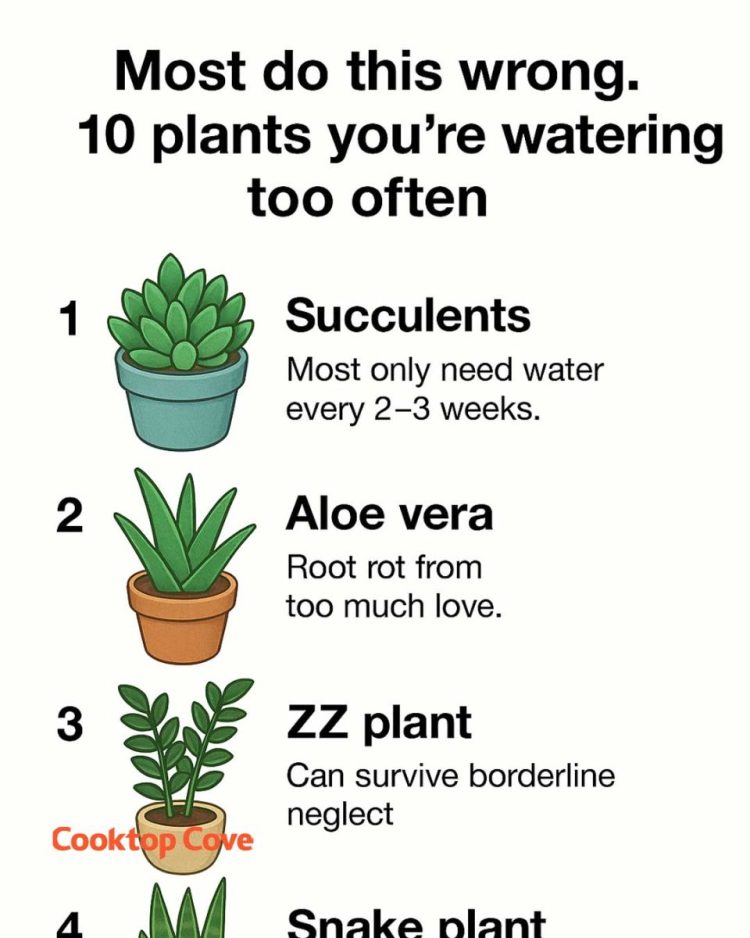Watering plants is a fundamental part of plant care, yet it’s one of the most common areas where plant enthusiasts go wrong. Overwatering is a widespread issue that can lead to root rot and other plant health problems. Many people assume that more water means better growth, but this isn’t always the case. Understanding the specific needs of each plant is crucial to avoid overwatering and to ensure your plants thrive.
In this article, we will explore ten popular plants that are often overwatered. By learning about their natural habitats and specific watering requirements, you can adjust your care routine to better suit their needs. This will not only improve the health of your plants but also save you time and effort in the long run.
1. The Overwatering Epidemic: Why Less Is More
Overwatering is a common mistake that can have detrimental effects on plant health. When plants receive too much water, their roots can suffocate due to lack of oxygen, leading to root rot. This is particularly true for plants that are adapted to arid environments. It’s important to remember that different plants have different water needs, and a one-size-fits-all approach can be harmful.
To avoid overwatering, it’s essential to understand the natural habitat of your plants. For example, plants native to desert regions require much less water than those from tropical rainforests. A good rule of thumb is to allow the top inch of soil to dry out before watering again, but this can vary depending on the plant species and environmental conditions.
2. Succulents: Thriving on Neglect
Succulents are adapted to survive in dry, arid environments, which means they require very little water. Overwatering is one of the most common reasons succulents fail to thrive. These plants store water in their leaves, so they can go weeks without needing additional moisture. It’s best to water succulents only when the soil is completely dry, which might be every two to three weeks depending on the climate and season.
When watering succulents, ensure that the pot has drainage holes to prevent water from pooling at the bottom. This helps prevent root rot and keeps the plant healthy. Remember, it’s better to underwater than overwater succulents.
3. Aloe Vera: A Resilient Survivor
Aloe Vera is a hardy plant that can withstand neglect and still thrive. Like other succulents, Aloe Vera stores water in its leaves and prefers to dry out completely between waterings. Overwatering can cause the leaves to become mushy and lead to root rot.
To care for Aloe Vera, water it deeply but infrequently. Allow the soil to dry out completely before watering again, which could be every three weeks or so. Ensure the pot has good drainage, and place the plant in a sunny spot to mimic its natural desert habitat.
4. ZZ Plant: The Ultimate Low-Maintenance Greenery
The ZZ Plant is known for its ability to tolerate low light and infrequent watering, making it a perfect choice for busy plant owners. This plant has rhizomes that store water, allowing it to survive long periods without moisture.
Water the ZZ Plant only when the soil is completely dry, which might be every two to three weeks. Overwatering can lead to yellowing leaves and root rot. It’s important to use a well-draining potting mix and a pot with drainage holes to prevent water from accumulating at the roots.
5. Snake Plant: A Hardy Houseplant
Snake Plants are incredibly resilient and can thrive on neglect. They are native to arid regions and prefer to dry out between waterings. Overwatering is a common mistake that can lead to root rot and other issues.
Water Snake Plants every two to six weeks, depending on the humidity and light conditions. Allow the soil to dry out completely before watering again. These plants do well in indirect light and can even tolerate low light conditions, making them versatile and easy to care for.
6. Cacti: Masters of Water Conservation
Cacti are the quintessential desert plants, adapted to survive in extreme drought conditions. They have evolved to store water in their thick, fleshy stems, allowing them to go long periods without additional moisture.
Water cacti sparingly, only when the soil is completely dry. This might mean watering them once a month or even less frequently during cooler months. Ensure the pot has excellent drainage and use a cactus-specific potting mix to prevent water from sitting at the roots.
7. Orchids: Delicate Yet Drought-Tolerant
see continuation on next page
